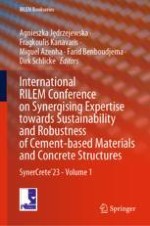2023 | OriginalPaper | Buchkapitel
Low Viscosity, High Temperature Stable Geopolymer for Crack Injection and Cavity Filling with Optional Increase of Volume and Preload
verfasst von : Hendrik Morgenstern, Michael Raupach
Verlag: Springer Nature Switzerland
Aktivieren Sie unsere intelligente Suche, um passende Fachinhalte oder Patente zu finden.
Wählen Sie Textabschnitte aus um mit Künstlicher Intelligenz passenden Patente zu finden. powered by
Markieren Sie Textabschnitte, um KI-gestützt weitere passende Inhalte zu finden. powered by
